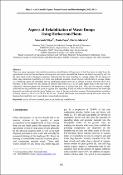Options
Aspects of rehabilitation of waste dumps using herbaceous plants
Date issued
2015
Author(s)
Abstract
There are many arguments that underlie research on rehabilitation of large areas of land that were set aside from the agricultural circuit and became heaps of storage for inert waste materials like bottom and boiler slag and fly ash. On the other hand result of biological materials with potential for land recycling i.e. sewage sludge. On the dumps of boiler slag composed of particles of 2-3 mm was gradually installed a layer of grass with the help of sewage sludge as a fertilizing agent and microbial activity stimulating agent, based on an extract of brown seaweed EKO GEA Slovenia. In the second year the amount of biomass harvested was 2 to 2.9 times higher than in the first year of cultivation. Moreover plants not harvested in the second year of culture bore fruit. Also, the root network strongly stabilized the slag and boiler ash particles against land spreading. Rapid and effective rehabilitation of the landscape destroyed was achieved with the use of herbaceous crops of the species Lolium perenne. Monitoring bioaccumulation of heavy metals i.e. Cd, Cr, Cu, Ni, Pb, Ni, Zn, etc. in aerial plant tissue was needed to decide the sector where the biomass harvested from inert waste dump covered with vegetation.
Files
Loading...
Name
Masu 2015 Reabilitare BDI.pdf
Size
114.06 KB
Format
Adobe PDF
Checksum
(MD5):ae55aaadda5c6ea66122700732bf6b22